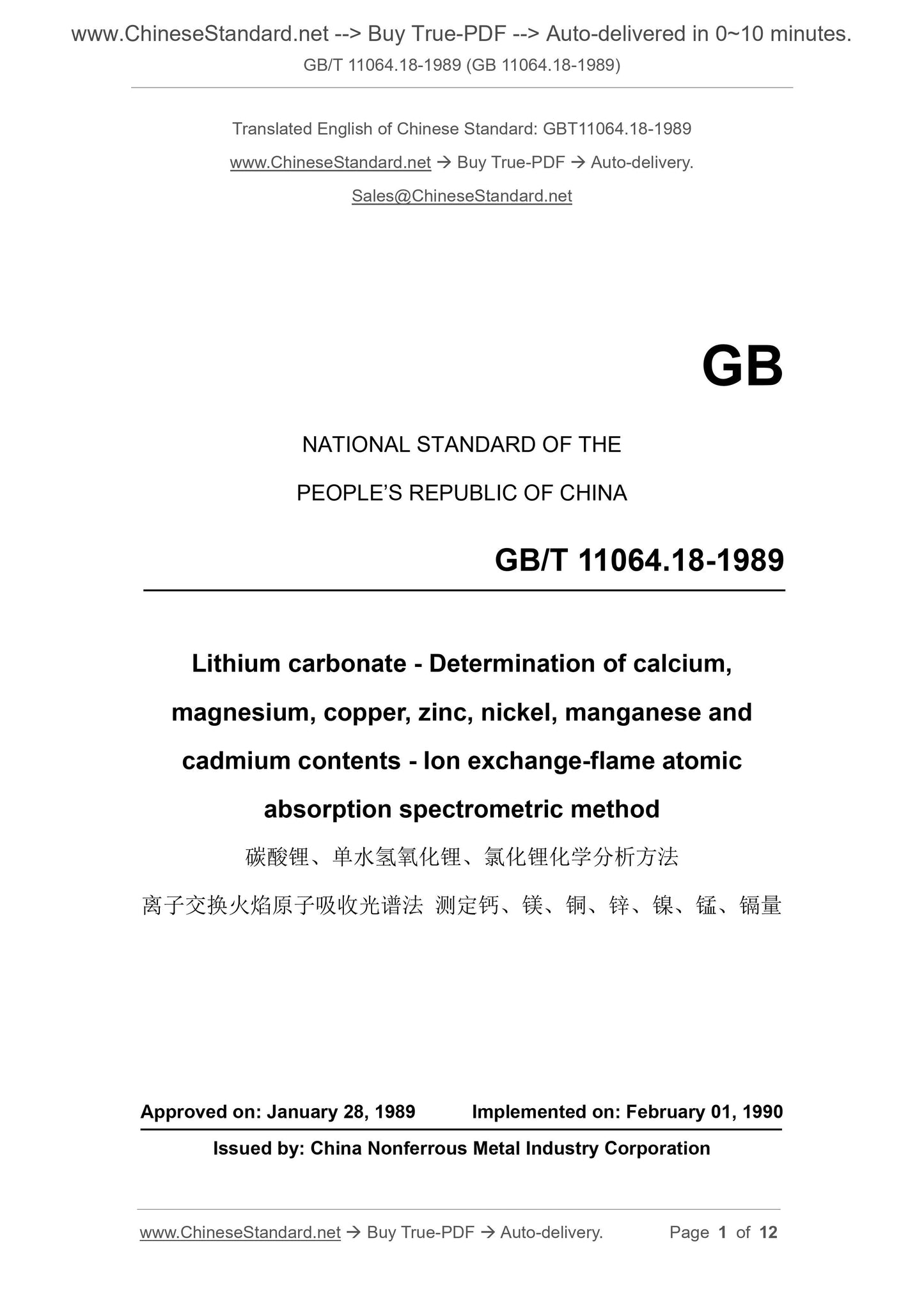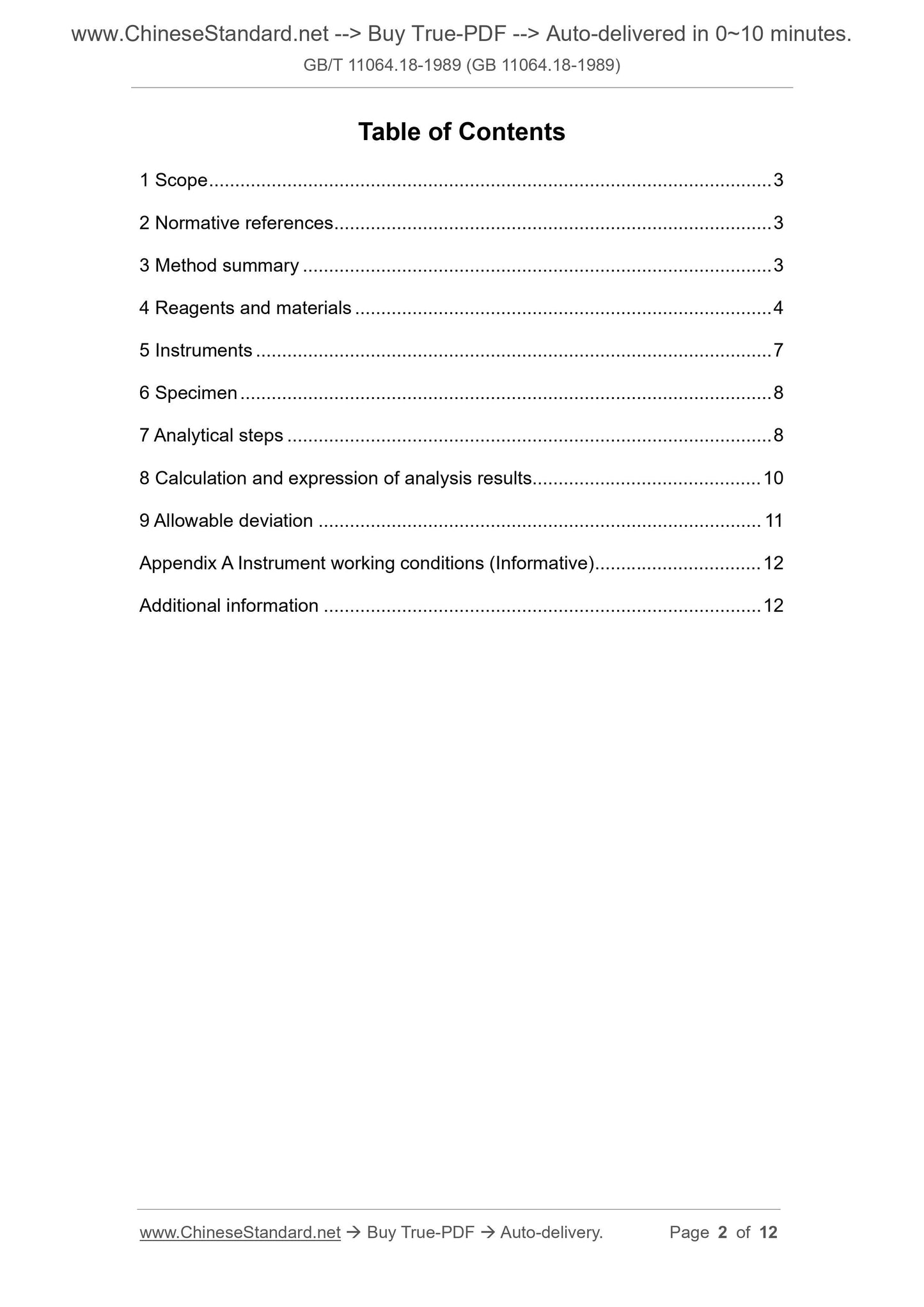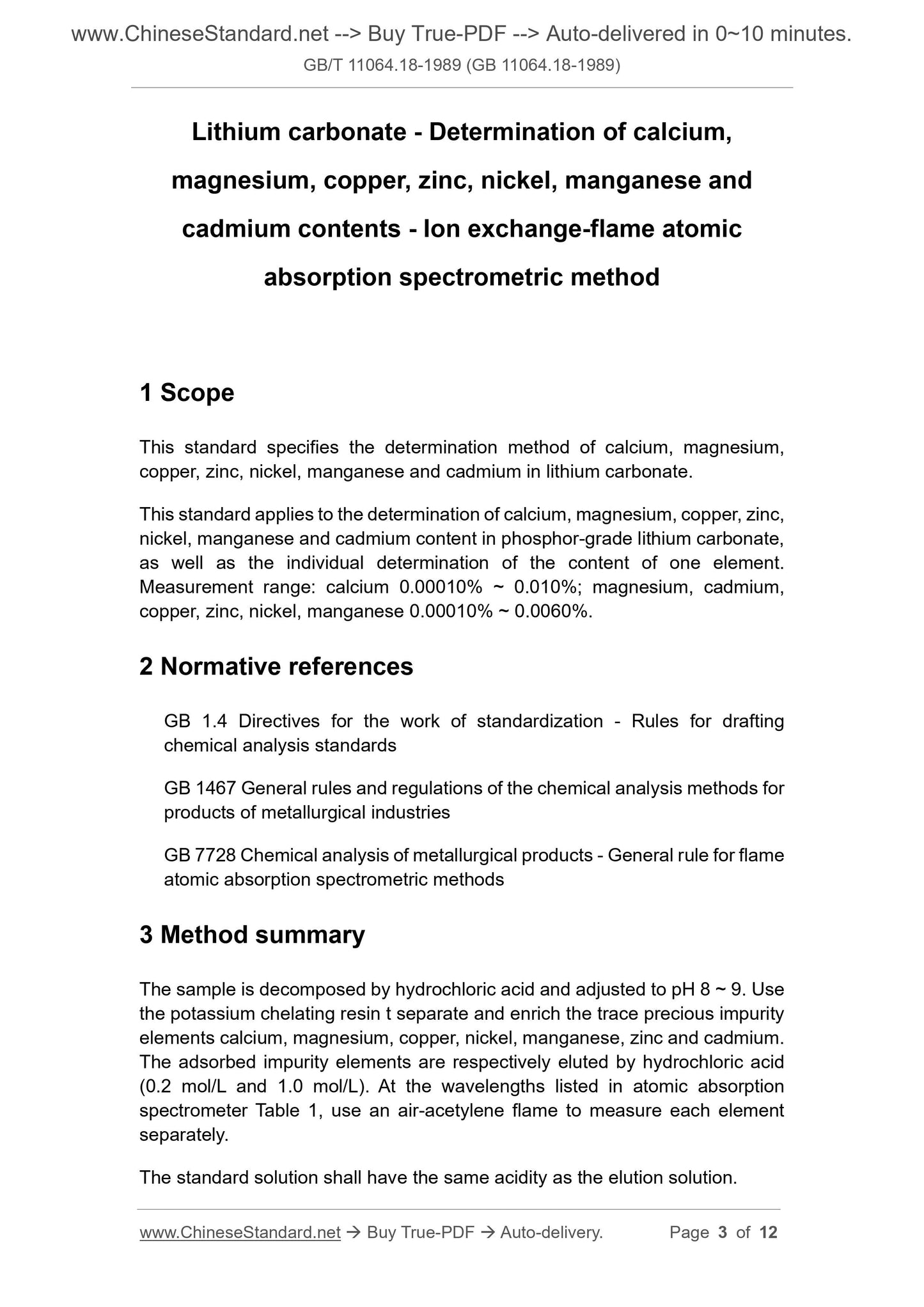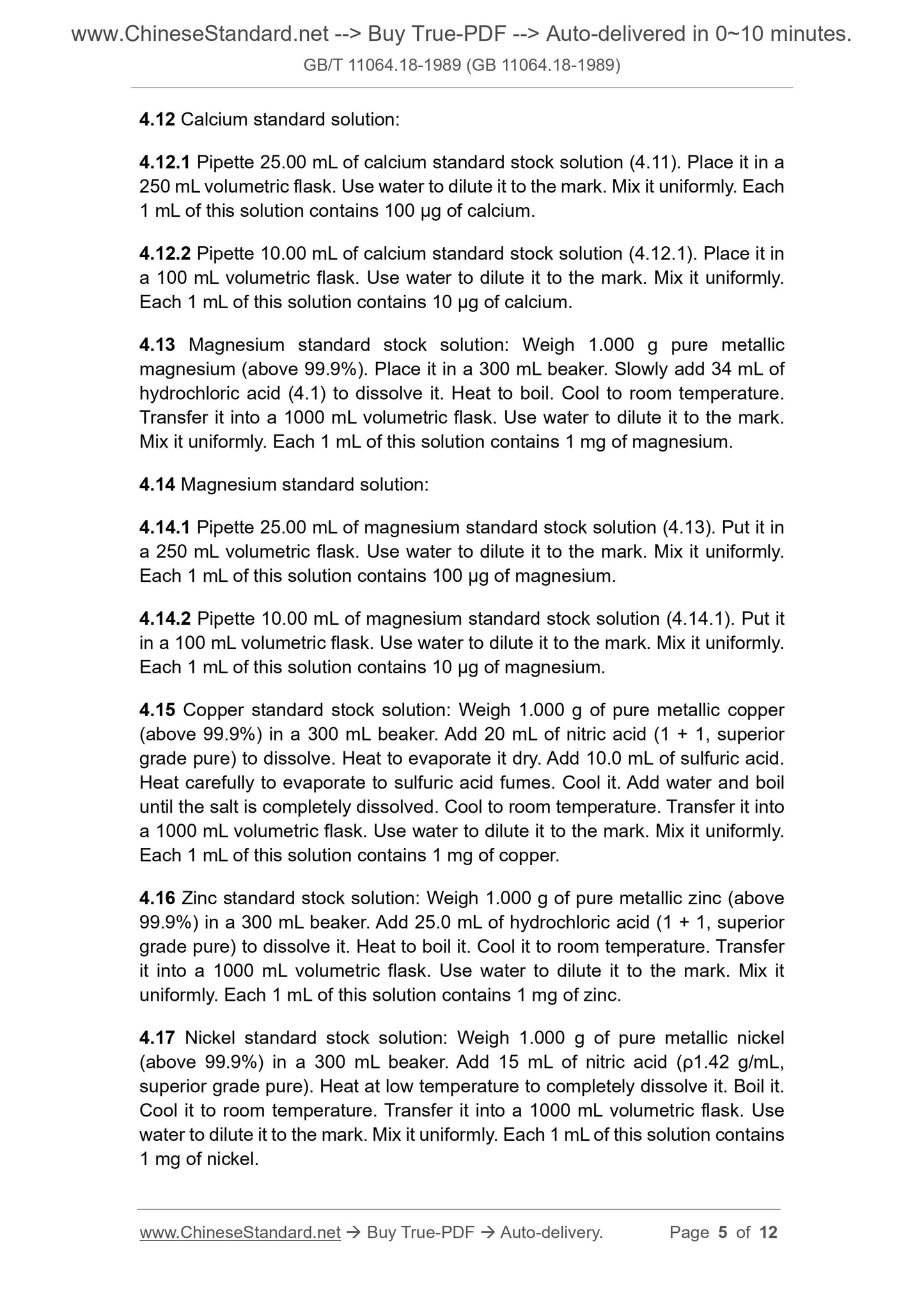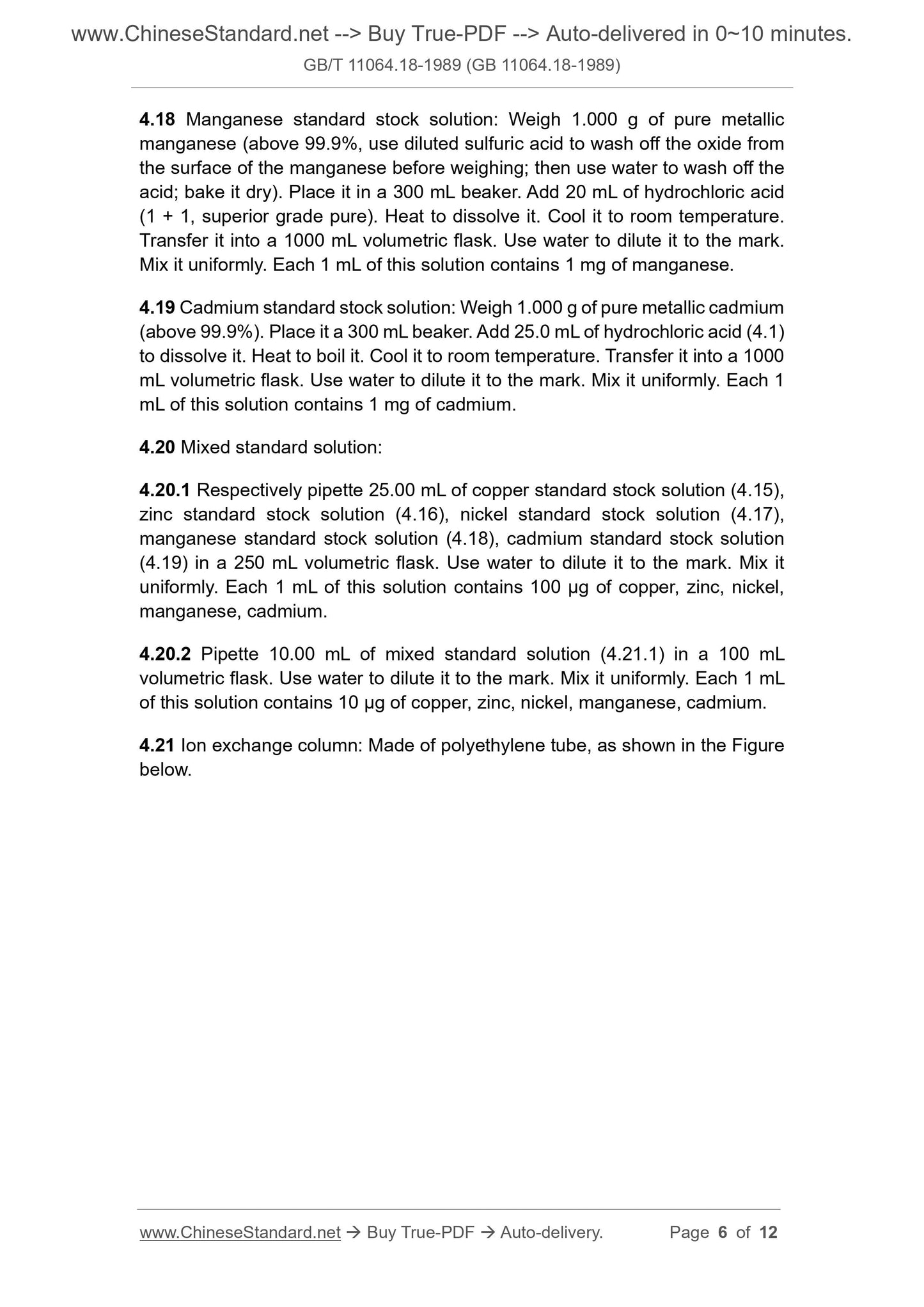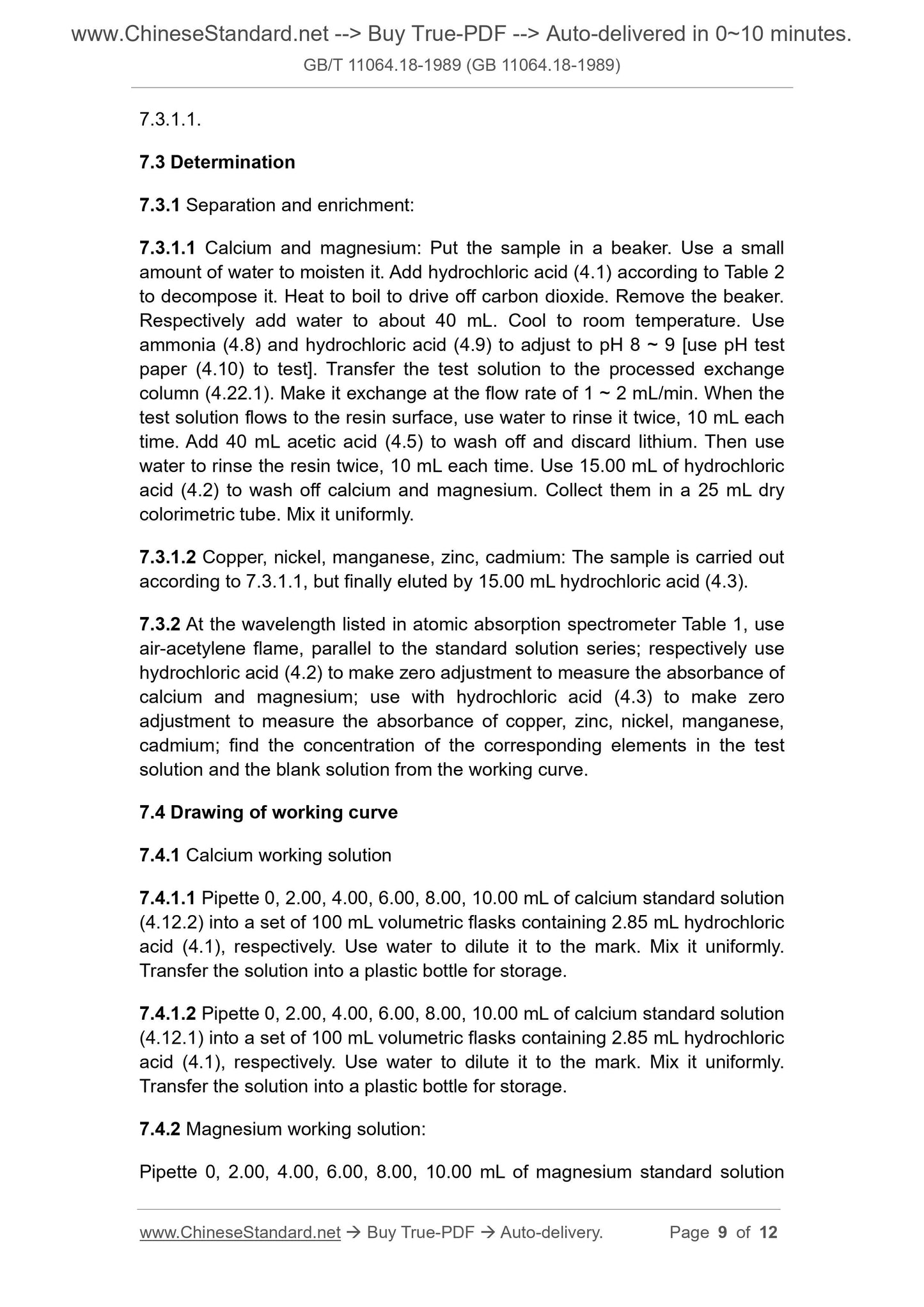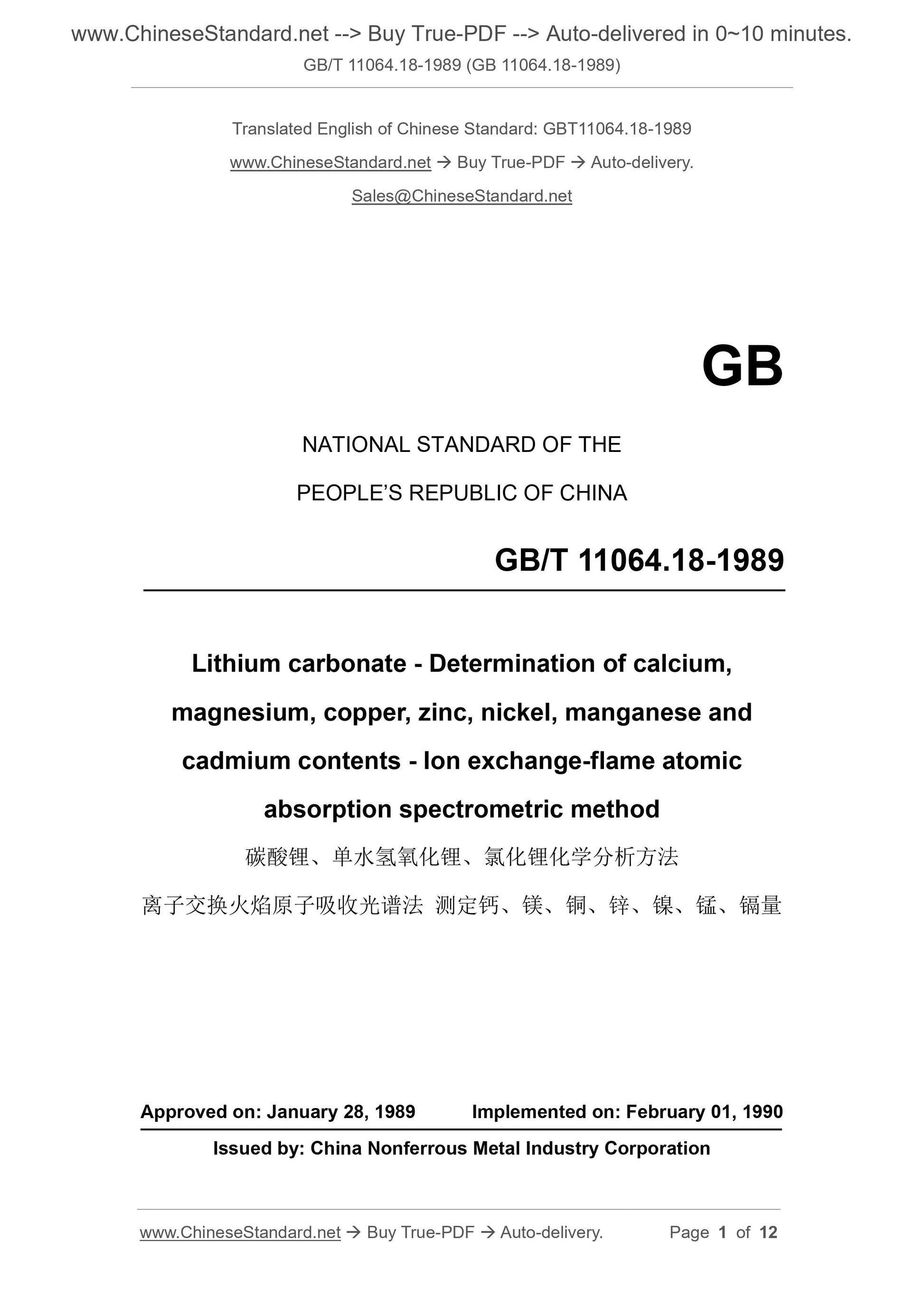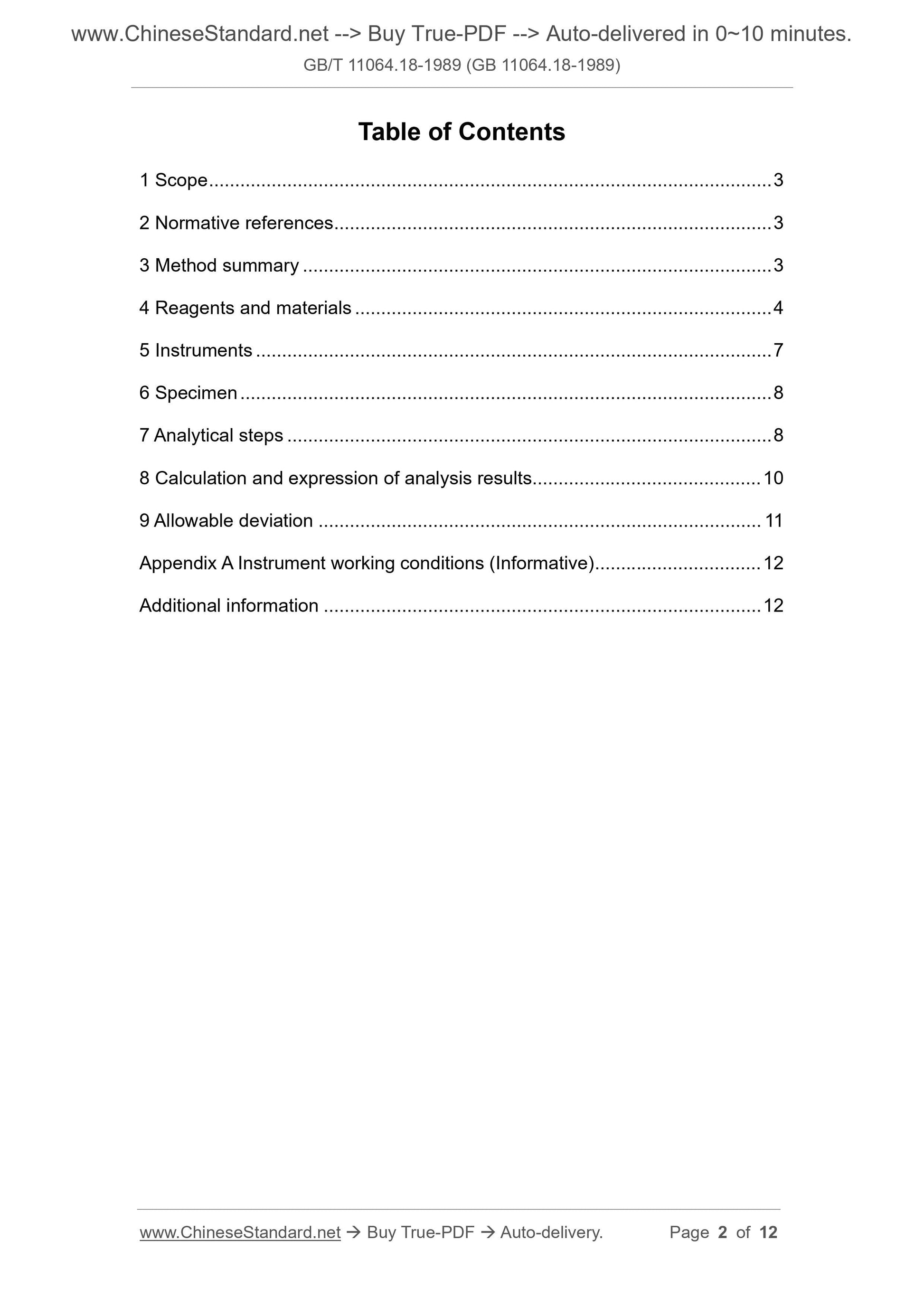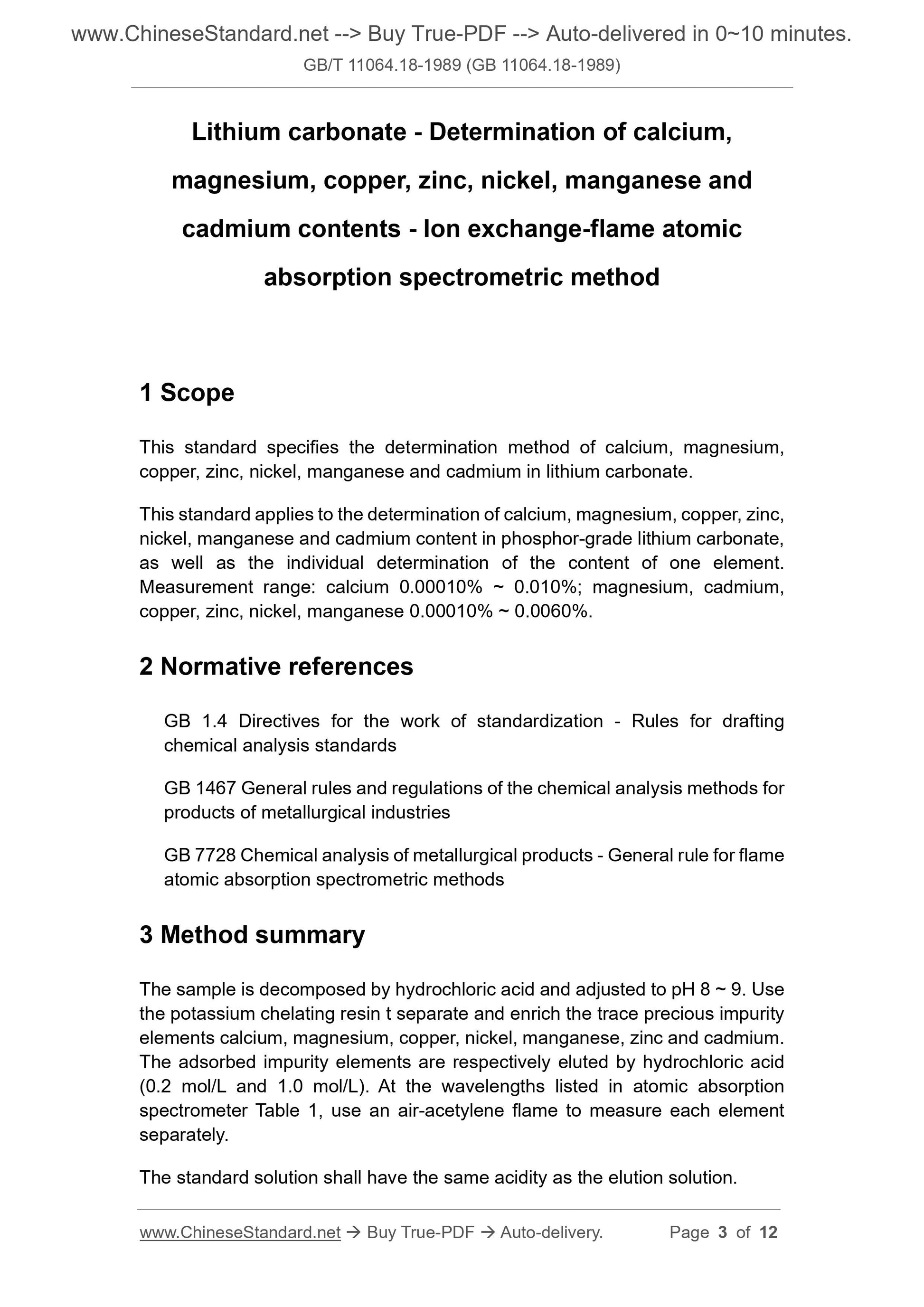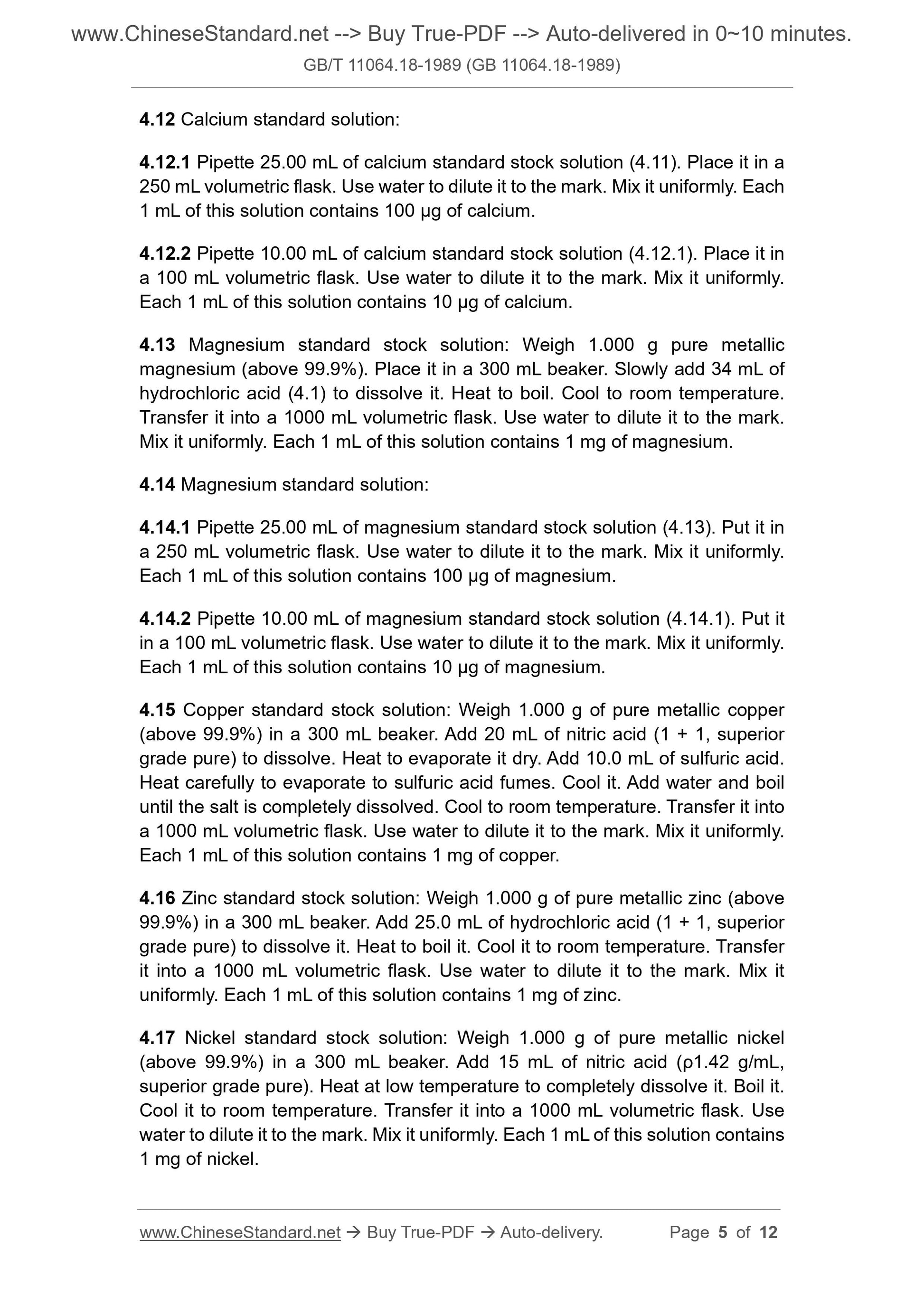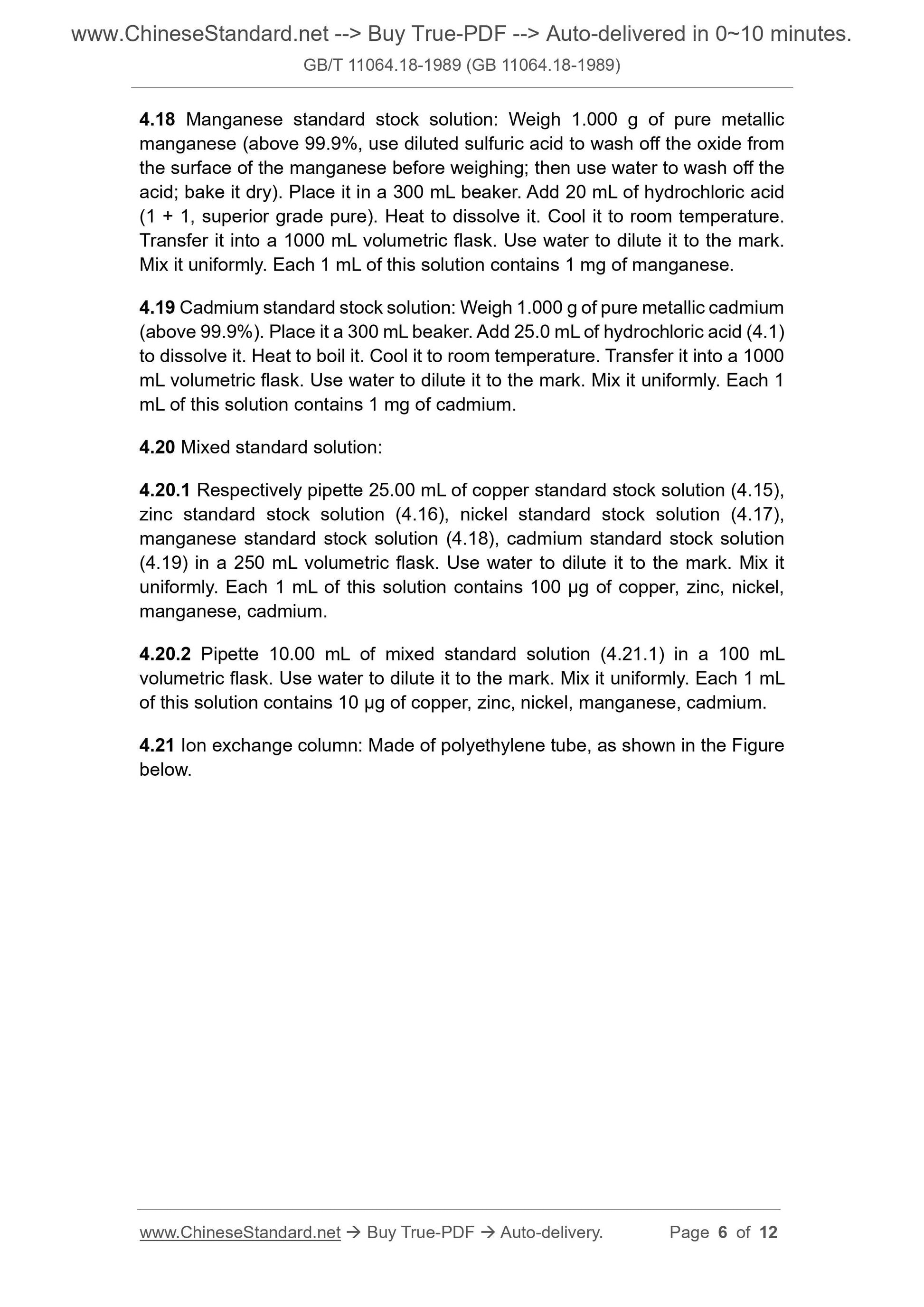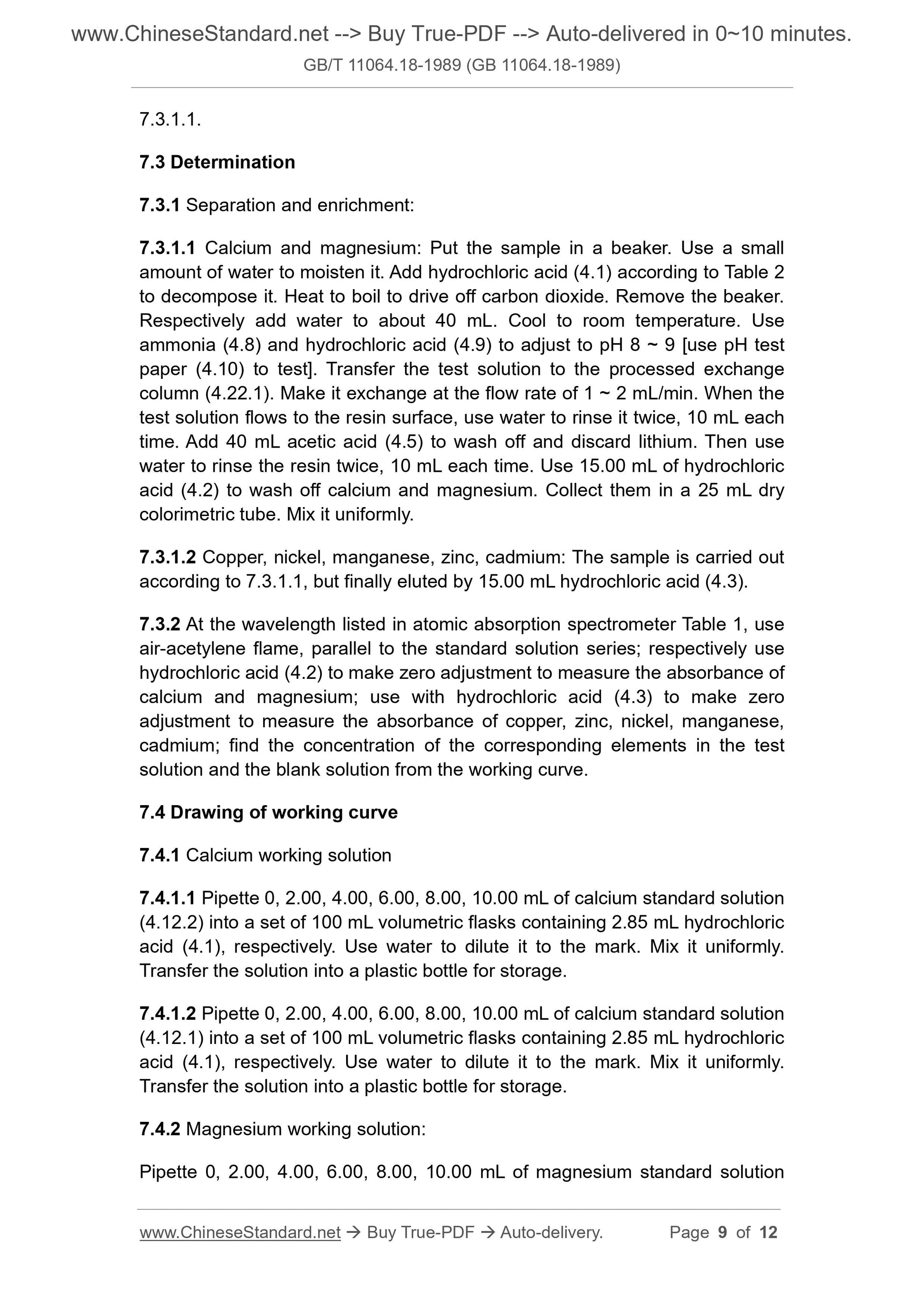1
/
of
6
www.ChineseStandard.us -- Field Test Asia Pte. Ltd.
GB/T 11064.18-1989 English PDF (GB/T11064.18-1989)
GB/T 11064.18-1989 English PDF (GB/T11064.18-1989)
Regular price
$205.00
Regular price
Sale price
$205.00
Unit price
/
per
Shipping calculated at checkout.
Couldn't load pickup availability
GB/T 11064.18-1989: Lithium carbonate--Determination of calcium, magnesium, copper, zinc, nickel, manganese and cadmium content--Ion exchange-flame atomic absorption spectrometric method
Delivery: 9 seconds. Download (& Email) true-PDF + Invoice.
Get Quotation: Click GB/T 11064.18-1989 (Self-service in 1-minute)
Historical versions (Master-website): GB/T 11064.18-1989
Preview True-PDF (Reload/Scroll-down if blank)
GB/T 11064.18-1989 (GB 11064.18-1989)
GB
NATIONAL STANDARD OF THE
PEOPLE’S REPUBLIC OF CHINA
GB/T 11064.18-1989
Lithium carbonate - Determination of calcium,
magnesium, copper, zinc, nickel, manganese and
cadmium contents - Ion exchange-flame atomic
absorption spectrometric method
APPROVED ON: JANUARY 28, 1989
IMPLEMENTED ON: FEBRUARY 01, 1990
Issued by: China Nonferrous Metal Industry Corporation
Table of Contents
1 Scope ... 3
2 Normative references ... 3
3 Method summary ... 3
4 Reagents and materials ... 4
5 Instruments ... 7
6 Specimen ... 8
7 Analytical steps ... 8
8 Calculation and expression of analysis results... 10
9 Allowable deviation ... 11
Appendix A Instrument working conditions (Informative) ... 12
Additional information ... 12
Lithium carbonate - Determination of calcium,
magnesium, copper, zinc, nickel, manganese and
cadmium contents - Ion exchange-flame atomic
absorption spectrometric method
1 Scope
This standard specifies the determination method of calcium, magnesium,
copper, zinc, nickel, manganese and cadmium in lithium carbonate.
This standard applies to the determination of calcium, magnesium, copper, zinc,
nickel, manganese and cadmium content in phosphor-grade lithium carbonate,
as well as the individual determination of the content of one element.
Measurement range: calcium 0.00010% ~ 0.010%; magnesium, cadmium,
copper, zinc, nickel, manganese 0.00010% ~ 0.0060%.
2 Normative references
GB 1.4 Directives for the work of standardization - Rules for drafting
chemical analysis standards
GB 1467 General rules and regulations of the chemical analysis methods for
products of metallurgical industries
GB 7728 Chemical analysis of metallurgical products - General rule for flame
atomic absorption spectrometric methods
3 Method summary
The sample is decomposed by hydrochloric acid and adjusted to pH 8 ~ 9. Use
the potassium chelating resin t separate and enrich the trace precious impurity
elements calcium, magnesium, copper, nickel, manganese, zinc and cadmium.
The adsorbed impurity elements are respectively eluted by hydrochloric acid
(0.2 mol/L and 1.0 mol/L). At the wavelengths listed in atomic absorption
spectrometer Table 1, use an air-acetylene flame to measure each element
separately.
The standard solution shall have the same acidity as the elution solution.
4.12 Calcium standard solution:
4.12.1 Pipette 25.00 mL of calcium standard stock solution (4.11). Place it in a
250 mL volumetric flask. Use water to dilute it to the mark. Mix it uniformly. Each
1 mL of this solution contains 100 µg of calcium.
4.12.2 Pipette 10.00 mL of calcium standard stock solution (4.12.1). Place it in
a 100 mL volumetric flask. Use water to dilute it to the mark. Mix it uniformly.
Each 1 mL of this solution contains 10 µg of calcium.
4.13 Magnesium standard stock solution: Weigh 1.000 g pure metallic
magnesium (above 99.9%). Place it in a 300 mL beaker. Slowly add 34 mL of
hydrochloric acid (4.1) to dissolve it. Heat to boil. Cool to room temperature.
Transfer it into a 1000 mL volumetric flask. Use water to dilute it to the mark.
Mix it uniformly. Each 1 mL of this solution contains 1 mg of magnesium.
4.14 Magnesium standard solution:
4.14.1 Pipette 25.00 mL of magnesium standard stock solution (4.13). Put it in
a 250 mL volumetric flask. Use water to dilute it to the mark. Mix it uniformly.
Each 1 mL of this solution contains 100 µg of magnesium.
4.14.2 Pipette 10.00 mL of magnesium standard stock solution (4.14.1). Put it
in a 100 mL volumetric flask. Use water to dilute it to the mark. Mix it uniformly.
Each 1 mL of this solution contains 10 µg of magnesium.
4.15 Copper standard stock solution: Weigh 1.000 g of pure metallic copper
(above 99.9%) in a 300 mL beaker. Add 20 mL of nitric acid (1 + 1, superior
grade pure) to dissolve. Heat to evaporate it dry. Add 10.0 mL of sulfuric acid.
Heat carefully to evaporate to sulfuric acid fumes. Cool it. Add water and boil
until the salt is completely dissolved. Cool to room temperature. Transfer it into
a 1000 mL volumetric flask. Use water to dilute it to the mark. Mix it uniformly.
Each 1 mL of this solution contains 1 mg of copper.
4.16 Zinc standard stock solution: Weigh 1.000 g of pure metallic zinc (above
99.9%) in a 300 mL beaker. Add 25.0 mL of hydrochloric acid (1 + 1, superior
grade pure) to dissolve it. Heat to boil it. Cool it to room temperature. Transfer
it into a 1000 mL volumetric flask. Use water to dilute it to the mark. Mix it
uniformly. Each 1 mL of this solution contains 1 mg of zinc.
4.17 Nickel standard stock solution: Weigh 1.000 g of pure metallic nickel
(above 99.9%) in a 300 mL beaker. Add 15 mL of nitric acid (ρ1.42 g/mL,
superior grade pure). Heat at low temperature to completely dissolve it. Boil it.
Cool it to room temperature. Transfer it into a 1000 mL volumetric flask. Use
water to dilute it to the mark. Mix it uniformly. Each 1 mL of this solution contains
1 mg of nickel.
4.18 Manganese standard stock solution: Weigh 1.000 g of pure metallic
manganese (above 99.9%, use diluted sulfuric acid to wash off the oxide from
the surface of the manganese before weighing; then use water to wash off the
acid; bake it dry). Place it in a 300 mL beaker. Add 20 mL of hydrochloric acid
(1 + 1, superior grade pure). Heat to dissolve it. Cool it to room temperature.
Transfer it into a 1000 mL volumetric flask. Use water to dilute it to the mark.
Mix it uniformly. Each 1 mL of this solution contains 1 mg of manganese.
4.19 Cadmium standard stock solution: Weigh 1.000 g of pure metallic cadmium
(above 99.9%). Place it a 300 mL beaker. Add 25.0 mL of hydrochloric acid (4.1)
to dissolve it. Heat to boil it. Cool it to room temperature. Transfer it into a 1000
mL volumetric flask. Use water to dilute it to the mark. Mix it uniformly. Each 1
mL of this solution contains 1 mg of cadmium.
4.20 Mixed standard solution:
4.20.1 Respectively pipette 25.00 mL of copper standard stock solution (4.15),
zinc standard stock solution (4.16), nickel standard stock solution (4.17),
manganese standard stock solution (4.18), cadmium standard stock solution
(4.19) in a 250 mL volumetric flask. Use water to dilute it to the mark. Mix it
uniformly. Each 1 mL of this solution contains 100 µg of copper, zinc, nickel,
manganese, cadmium.
4.20.2 Pipette 10.00 mL of mixed standard solution (4.21.1) in a 100 mL
volumetric flask. Use water to dilute it to the mark. Mix it uniformly. Each 1 mL
of this solution contains 10 µg of copper, zinc, nickel, manganese, cadmium.
4.21 Ion exchange column: Made of polyethylene tube, as shown in the Figure
below.
7.3.1.1.
7.3 Determination
7.3.1 Separation and enrichment:
7.3.1.1 Calcium and magnesium: Put the sample in a beaker. Use a small
amount of water to moisten it. Add hydrochloric acid (4.1) according to Table 2
to decompose it. Heat to boil to drive off carbon dioxide. Remove the beaker.
Respectively add water to about 40 mL. Cool to room temperature. Use
ammonia (4.8) and hydrochloric acid (4.9) to adjust to pH 8 ~ 9 [use pH test
paper (4.10) to test]. Transfer the test solution to the processed exchange
column (4.22.1). Make it exchange at the flow rate of 1 ~ 2 mL/min. When the
test solution flows to the resin surface, use water to rinse it twice, 10 mL each
time. Add 40 mL acetic acid (4.5) to wash off and discard lithium. Then use
water to rinse the resin twice, 10 mL each time. Use 15.00 mL of hydrochloric
acid (4.2) to wash off calcium and magnesium. Collect them in a 25 mL dry
colorimetric tube. Mix it uniformly.
7.3.1.2 Copper, nickel, manganese, zinc, cadmium: The sample is carried out
according to 7.3.1.1, but finally eluted by 15.00 mL hydrochloric acid (4.3).
7.3.2 At the wavelength listed in atomic absorption spectrometer Table 1, use
air-acetylene flame, parallel to the standard solution series; respectively use
hydrochloric acid (4.2) to make zero adjustment to measure the absorbance of
calcium and magnesium; use with hydrochloric acid (4.3) to make zero
adjustment to measure the absorbance of copper, zinc, nickel, manganese,
cadmium; find the concentration of the corresponding elements in the test
solution and the blank solution from the working curve.
7.4 Drawing of working curve
7.4.1 Calcium working solution
7.4.1.1 Pipette 0, 2.00, 4.00, 6.00, 8.00, 10.00 mL of calcium standard solution
(4.12.2) into a set of 100 mL volumetric flasks containing 2.85 mL hydrochloric
acid (4.1), respectively. Use water to dilute it to the mark. Mix it uniformly.
Transfer the solution into a plastic bottle for storage.
7.4.1.2 Pipette 0, 2.00, 4.00, 6.00, 8.00, 10.00 mL of calcium standard solution
(4.12.1) into a set of 100 mL volumetric flasks containing 2.85 mL hydrochloric
acid (4.1), respectively. Use water to dilute it to the mark. Mix it uniformly.
Transfer the solution into a plastic bottle for storage.
7.4.2 Magnesium working solution:
Pipette 0, 2.00, 4.00, 6.00, 8.00, 10.00 mL of magnesium standard solution
GB/T 11064.18-1989 (GB 11064.18-1989)
GB
NATIONAL STANDARD OF THE
PEOPLE’S REPUBLIC OF CHINA
GB/T 11064.18-1989
Lithium carbonate - Determination of calcium,
magnesium, copper, zinc, nickel, manganese and
cadmium contents - Ion exchange-flame atomic
absorption spectrometric method
APPROVED ON: JANUARY 28, 1989
IMPLEMENTED ON: FEBRUARY 01, 1990
Issued by: China Nonferrous Metal Industry Corporation
Table of Contents
1 Scope ... 3
2 Normative references ... 3
3 Method summary ... 3
4 Reagents and materials ... 4
5 Instruments ... 7
6 Specimen ... 8
7 Analytical steps ... 8
8 Calculation and expression of analysis results... 10
9 Allowable deviation ... 11
Appendix A Instrument working conditions (Informative) ... 12
Additional information ... 12
Lithium carbonate - Determination of calcium,
magnesium, copper, zinc, nickel, manganese and
cadmium contents - Ion exchange-flame atomic
absorption spectrometric method
1 Scope
This standard specifies the determination method of calcium, magnesium,
copper, zinc, nickel, manganese and cadmium in lithium carbonate.
This standard applies to the determination of calcium, magnesium, copper, zinc,
nickel, manganese and cadmium content in phosphor-grade lithium carbonate,
as well as the individual determination of the content of one element.
Measurement range: calcium 0.00010% ~ 0.010%; magnesium, cadmium,
copper, zinc, nickel, manganese 0.00010% ~ 0.0060%.
2 Normative references
GB 1.4 Directives for the work of standardization - Rules for drafting
chemical analysis standards
GB 1467 General rules and regulations of the chemical analysis methods for
products of metallurgical industries
GB 7728 Chemical analysis of metallurgical products - General rule for flame
atomic absorption spectrometric methods
3 Method summary
The sample is decomposed by hydrochloric acid and adjusted to pH 8 ~ 9. Use
the potassium chelating resin t separate and enrich the trace precious impurity
elements calcium, magnesium, copper, nickel, manganese, zinc and cadmium.
The adsorbed impurity elements are respectively eluted by hydrochloric acid
(0.2 mol/L and 1.0 mol/L). At the wavelengths listed in atomic absorption
spectrometer Table 1, use an air-acetylene flame to measure each element
separately.
The standard solution shall have the same acidity as the elution solution.
4.12 Calcium standard solution:
4.12.1 Pipette 25.00 mL of calcium standard stock solution (4.11). Place it in a
250 mL volumetric flask. Use water to dilute it to the mark. Mix it uniformly. Each
1 mL of this solution contains 100 µg of calcium.
4.12.2 Pipette 10.00 mL of calcium standard stock solution (4.12.1). Place it in
a 100 mL volumetric flask. Use water to dilute it to the mark. Mix it uniformly.
Each 1 mL of this solution contains 10 µg of calcium.
4.13 Magnesium standard stock solution: Weigh 1.000 g pure metallic
magnesium (above 99.9%). Place it in a 300 mL beaker. Slowly add 34 mL of
hydrochloric acid (4.1) to dissolve it. Heat to boil. Cool to room temperature.
Transfer it into a 1000 mL volumetric flask. Use water to dilute it to the mark.
Mix it uniformly. Each 1 mL of this solution contains 1 mg of magnesium.
4.14 Magnesium standard solution:
4.14.1 Pipette 25.00 mL of magnesium standard stock solution (4.13). Put it in
a 250 mL volumetric flask. Use water to dilute it to the mark. Mix it uniformly.
Each 1 mL of this solution contains 100 µg of magnesium.
4.14.2 Pipette 10.00 mL of magnesium standard stock solution (4.14.1). Put it
in a 100 mL volumetric flask. Use water to dilute it to the mark. Mix it uniformly.
Each 1 mL of this solution contains 10 µg of magnesium.
4.15 Copper standard stock solution: Weigh 1.000 g of pure metallic copper
(above 99.9%) in a 300 mL beaker. Add 20 mL of nitric acid (1 + 1, superior
grade pure) to dissolve. Heat to evaporate it dry. Add 10.0 mL of sulfuric acid.
Heat carefully to evaporate to sulfuric acid fumes. Cool it. Add water and boil
until the salt is completely dissolved. Cool to room temperature. Transfer it into
a 1000 mL volumetric flask. Use water to dilute it to the mark. Mix it uniformly.
Each 1 mL of this solution contains 1 mg of copper.
4.16 Zinc standard stock solution: Weigh 1.000 g of pure metallic zinc (above
99.9%) in a 300 mL beaker. Add 25.0 mL of hydrochloric acid (1 + 1, superior
grade pure) to dissolve it. Heat to boil it. Cool it to room temperature. Transfer
it into a 1000 mL volumetric flask. Use water to dilute it to the mark. Mix it
uniformly. Each 1 mL of this solution contains 1 mg of zinc.
4.17 Nickel standard stock solution: Weigh 1.000 g of pure metallic nickel
(above 99.9%) in a 300 mL beaker. Add 15 mL of nitric acid (ρ1.42 g/mL,
superior grade pure). Heat at low temperature to completely dissolve it. Boil it.
Cool it to room temperature. Transfer it into a 1000 mL volumetric f...
Delivery: 9 seconds. Download (& Email) true-PDF + Invoice.
Get Quotation: Click GB/T 11064.18-1989 (Self-service in 1-minute)
Historical versions (Master-website): GB/T 11064.18-1989
Preview True-PDF (Reload/Scroll-down if blank)
GB/T 11064.18-1989 (GB 11064.18-1989)
GB
NATIONAL STANDARD OF THE
PEOPLE’S REPUBLIC OF CHINA
GB/T 11064.18-1989
Lithium carbonate - Determination of calcium,
magnesium, copper, zinc, nickel, manganese and
cadmium contents - Ion exchange-flame atomic
absorption spectrometric method
APPROVED ON: JANUARY 28, 1989
IMPLEMENTED ON: FEBRUARY 01, 1990
Issued by: China Nonferrous Metal Industry Corporation
Table of Contents
1 Scope ... 3
2 Normative references ... 3
3 Method summary ... 3
4 Reagents and materials ... 4
5 Instruments ... 7
6 Specimen ... 8
7 Analytical steps ... 8
8 Calculation and expression of analysis results... 10
9 Allowable deviation ... 11
Appendix A Instrument working conditions (Informative) ... 12
Additional information ... 12
Lithium carbonate - Determination of calcium,
magnesium, copper, zinc, nickel, manganese and
cadmium contents - Ion exchange-flame atomic
absorption spectrometric method
1 Scope
This standard specifies the determination method of calcium, magnesium,
copper, zinc, nickel, manganese and cadmium in lithium carbonate.
This standard applies to the determination of calcium, magnesium, copper, zinc,
nickel, manganese and cadmium content in phosphor-grade lithium carbonate,
as well as the individual determination of the content of one element.
Measurement range: calcium 0.00010% ~ 0.010%; magnesium, cadmium,
copper, zinc, nickel, manganese 0.00010% ~ 0.0060%.
2 Normative references
GB 1.4 Directives for the work of standardization - Rules for drafting
chemical analysis standards
GB 1467 General rules and regulations of the chemical analysis methods for
products of metallurgical industries
GB 7728 Chemical analysis of metallurgical products - General rule for flame
atomic absorption spectrometric methods
3 Method summary
The sample is decomposed by hydrochloric acid and adjusted to pH 8 ~ 9. Use
the potassium chelating resin t separate and enrich the trace precious impurity
elements calcium, magnesium, copper, nickel, manganese, zinc and cadmium.
The adsorbed impurity elements are respectively eluted by hydrochloric acid
(0.2 mol/L and 1.0 mol/L). At the wavelengths listed in atomic absorption
spectrometer Table 1, use an air-acetylene flame to measure each element
separately.
The standard solution shall have the same acidity as the elution solution.
4.12 Calcium standard solution:
4.12.1 Pipette 25.00 mL of calcium standard stock solution (4.11). Place it in a
250 mL volumetric flask. Use water to dilute it to the mark. Mix it uniformly. Each
1 mL of this solution contains 100 µg of calcium.
4.12.2 Pipette 10.00 mL of calcium standard stock solution (4.12.1). Place it in
a 100 mL volumetric flask. Use water to dilute it to the mark. Mix it uniformly.
Each 1 mL of this solution contains 10 µg of calcium.
4.13 Magnesium standard stock solution: Weigh 1.000 g pure metallic
magnesium (above 99.9%). Place it in a 300 mL beaker. Slowly add 34 mL of
hydrochloric acid (4.1) to dissolve it. Heat to boil. Cool to room temperature.
Transfer it into a 1000 mL volumetric flask. Use water to dilute it to the mark.
Mix it uniformly. Each 1 mL of this solution contains 1 mg of magnesium.
4.14 Magnesium standard solution:
4.14.1 Pipette 25.00 mL of magnesium standard stock solution (4.13). Put it in
a 250 mL volumetric flask. Use water to dilute it to the mark. Mix it uniformly.
Each 1 mL of this solution contains 100 µg of magnesium.
4.14.2 Pipette 10.00 mL of magnesium standard stock solution (4.14.1). Put it
in a 100 mL volumetric flask. Use water to dilute it to the mark. Mix it uniformly.
Each 1 mL of this solution contains 10 µg of magnesium.
4.15 Copper standard stock solution: Weigh 1.000 g of pure metallic copper
(above 99.9%) in a 300 mL beaker. Add 20 mL of nitric acid (1 + 1, superior
grade pure) to dissolve. Heat to evaporate it dry. Add 10.0 mL of sulfuric acid.
Heat carefully to evaporate to sulfuric acid fumes. Cool it. Add water and boil
until the salt is completely dissolved. Cool to room temperature. Transfer it into
a 1000 mL volumetric flask. Use water to dilute it to the mark. Mix it uniformly.
Each 1 mL of this solution contains 1 mg of copper.
4.16 Zinc standard stock solution: Weigh 1.000 g of pure metallic zinc (above
99.9%) in a 300 mL beaker. Add 25.0 mL of hydrochloric acid (1 + 1, superior
grade pure) to dissolve it. Heat to boil it. Cool it to room temperature. Transfer
it into a 1000 mL volumetric flask. Use water to dilute it to the mark. Mix it
uniformly. Each 1 mL of this solution contains 1 mg of zinc.
4.17 Nickel standard stock solution: Weigh 1.000 g of pure metallic nickel
(above 99.9%) in a 300 mL beaker. Add 15 mL of nitric acid (ρ1.42 g/mL,
superior grade pure). Heat at low temperature to completely dissolve it. Boil it.
Cool it to room temperature. Transfer it into a 1000 mL volumetric flask. Use
water to dilute it to the mark. Mix it uniformly. Each 1 mL of this solution contains
1 mg of nickel.
4.18 Manganese standard stock solution: Weigh 1.000 g of pure metallic
manganese (above 99.9%, use diluted sulfuric acid to wash off the oxide from
the surface of the manganese before weighing; then use water to wash off the
acid; bake it dry). Place it in a 300 mL beaker. Add 20 mL of hydrochloric acid
(1 + 1, superior grade pure). Heat to dissolve it. Cool it to room temperature.
Transfer it into a 1000 mL volumetric flask. Use water to dilute it to the mark.
Mix it uniformly. Each 1 mL of this solution contains 1 mg of manganese.
4.19 Cadmium standard stock solution: Weigh 1.000 g of pure metallic cadmium
(above 99.9%). Place it a 300 mL beaker. Add 25.0 mL of hydrochloric acid (4.1)
to dissolve it. Heat to boil it. Cool it to room temperature. Transfer it into a 1000
mL volumetric flask. Use water to dilute it to the mark. Mix it uniformly. Each 1
mL of this solution contains 1 mg of cadmium.
4.20 Mixed standard solution:
4.20.1 Respectively pipette 25.00 mL of copper standard stock solution (4.15),
zinc standard stock solution (4.16), nickel standard stock solution (4.17),
manganese standard stock solution (4.18), cadmium standard stock solution
(4.19) in a 250 mL volumetric flask. Use water to dilute it to the mark. Mix it
uniformly. Each 1 mL of this solution contains 100 µg of copper, zinc, nickel,
manganese, cadmium.
4.20.2 Pipette 10.00 mL of mixed standard solution (4.21.1) in a 100 mL
volumetric flask. Use water to dilute it to the mark. Mix it uniformly. Each 1 mL
of this solution contains 10 µg of copper, zinc, nickel, manganese, cadmium.
4.21 Ion exchange column: Made of polyethylene tube, as shown in the Figure
below.
7.3.1.1.
7.3 Determination
7.3.1 Separation and enrichment:
7.3.1.1 Calcium and magnesium: Put the sample in a beaker. Use a small
amount of water to moisten it. Add hydrochloric acid (4.1) according to Table 2
to decompose it. Heat to boil to drive off carbon dioxide. Remove the beaker.
Respectively add water to about 40 mL. Cool to room temperature. Use
ammonia (4.8) and hydrochloric acid (4.9) to adjust to pH 8 ~ 9 [use pH test
paper (4.10) to test]. Transfer the test solution to the processed exchange
column (4.22.1). Make it exchange at the flow rate of 1 ~ 2 mL/min. When the
test solution flows to the resin surface, use water to rinse it twice, 10 mL each
time. Add 40 mL acetic acid (4.5) to wash off and discard lithium. Then use
water to rinse the resin twice, 10 mL each time. Use 15.00 mL of hydrochloric
acid (4.2) to wash off calcium and magnesium. Collect them in a 25 mL dry
colorimetric tube. Mix it uniformly.
7.3.1.2 Copper, nickel, manganese, zinc, cadmium: The sample is carried out
according to 7.3.1.1, but finally eluted by 15.00 mL hydrochloric acid (4.3).
7.3.2 At the wavelength listed in atomic absorption spectrometer Table 1, use
air-acetylene flame, parallel to the standard solution series; respectively use
hydrochloric acid (4.2) to make zero adjustment to measure the absorbance of
calcium and magnesium; use with hydrochloric acid (4.3) to make zero
adjustment to measure the absorbance of copper, zinc, nickel, manganese,
cadmium; find the concentration of the corresponding elements in the test
solution and the blank solution from the working curve.
7.4 Drawing of working curve
7.4.1 Calcium working solution
7.4.1.1 Pipette 0, 2.00, 4.00, 6.00, 8.00, 10.00 mL of calcium standard solution
(4.12.2) into a set of 100 mL volumetric flasks containing 2.85 mL hydrochloric
acid (4.1), respectively. Use water to dilute it to the mark. Mix it uniformly.
Transfer the solution into a plastic bottle for storage.
7.4.1.2 Pipette 0, 2.00, 4.00, 6.00, 8.00, 10.00 mL of calcium standard solution
(4.12.1) into a set of 100 mL volumetric flasks containing 2.85 mL hydrochloric
acid (4.1), respectively. Use water to dilute it to the mark. Mix it uniformly.
Transfer the solution into a plastic bottle for storage.
7.4.2 Magnesium working solution:
Pipette 0, 2.00, 4.00, 6.00, 8.00, 10.00 mL of magnesium standard solution
GB/T 11064.18-1989 (GB 11064.18-1989)
GB
NATIONAL STANDARD OF THE
PEOPLE’S REPUBLIC OF CHINA
GB/T 11064.18-1989
Lithium carbonate - Determination of calcium,
magnesium, copper, zinc, nickel, manganese and
cadmium contents - Ion exchange-flame atomic
absorption spectrometric method
APPROVED ON: JANUARY 28, 1989
IMPLEMENTED ON: FEBRUARY 01, 1990
Issued by: China Nonferrous Metal Industry Corporation
Table of Contents
1 Scope ... 3
2 Normative references ... 3
3 Method summary ... 3
4 Reagents and materials ... 4
5 Instruments ... 7
6 Specimen ... 8
7 Analytical steps ... 8
8 Calculation and expression of analysis results... 10
9 Allowable deviation ... 11
Appendix A Instrument working conditions (Informative) ... 12
Additional information ... 12
Lithium carbonate - Determination of calcium,
magnesium, copper, zinc, nickel, manganese and
cadmium contents - Ion exchange-flame atomic
absorption spectrometric method
1 Scope
This standard specifies the determination method of calcium, magnesium,
copper, zinc, nickel, manganese and cadmium in lithium carbonate.
This standard applies to the determination of calcium, magnesium, copper, zinc,
nickel, manganese and cadmium content in phosphor-grade lithium carbonate,
as well as the individual determination of the content of one element.
Measurement range: calcium 0.00010% ~ 0.010%; magnesium, cadmium,
copper, zinc, nickel, manganese 0.00010% ~ 0.0060%.
2 Normative references
GB 1.4 Directives for the work of standardization - Rules for drafting
chemical analysis standards
GB 1467 General rules and regulations of the chemical analysis methods for
products of metallurgical industries
GB 7728 Chemical analysis of metallurgical products - General rule for flame
atomic absorption spectrometric methods
3 Method summary
The sample is decomposed by hydrochloric acid and adjusted to pH 8 ~ 9. Use
the potassium chelating resin t separate and enrich the trace precious impurity
elements calcium, magnesium, copper, nickel, manganese, zinc and cadmium.
The adsorbed impurity elements are respectively eluted by hydrochloric acid
(0.2 mol/L and 1.0 mol/L). At the wavelengths listed in atomic absorption
spectrometer Table 1, use an air-acetylene flame to measure each element
separately.
The standard solution shall have the same acidity as the elution solution.
4.12 Calcium standard solution:
4.12.1 Pipette 25.00 mL of calcium standard stock solution (4.11). Place it in a
250 mL volumetric flask. Use water to dilute it to the mark. Mix it uniformly. Each
1 mL of this solution contains 100 µg of calcium.
4.12.2 Pipette 10.00 mL of calcium standard stock solution (4.12.1). Place it in
a 100 mL volumetric flask. Use water to dilute it to the mark. Mix it uniformly.
Each 1 mL of this solution contains 10 µg of calcium.
4.13 Magnesium standard stock solution: Weigh 1.000 g pure metallic
magnesium (above 99.9%). Place it in a 300 mL beaker. Slowly add 34 mL of
hydrochloric acid (4.1) to dissolve it. Heat to boil. Cool to room temperature.
Transfer it into a 1000 mL volumetric flask. Use water to dilute it to the mark.
Mix it uniformly. Each 1 mL of this solution contains 1 mg of magnesium.
4.14 Magnesium standard solution:
4.14.1 Pipette 25.00 mL of magnesium standard stock solution (4.13). Put it in
a 250 mL volumetric flask. Use water to dilute it to the mark. Mix it uniformly.
Each 1 mL of this solution contains 100 µg of magnesium.
4.14.2 Pipette 10.00 mL of magnesium standard stock solution (4.14.1). Put it
in a 100 mL volumetric flask. Use water to dilute it to the mark. Mix it uniformly.
Each 1 mL of this solution contains 10 µg of magnesium.
4.15 Copper standard stock solution: Weigh 1.000 g of pure metallic copper
(above 99.9%) in a 300 mL beaker. Add 20 mL of nitric acid (1 + 1, superior
grade pure) to dissolve. Heat to evaporate it dry. Add 10.0 mL of sulfuric acid.
Heat carefully to evaporate to sulfuric acid fumes. Cool it. Add water and boil
until the salt is completely dissolved. Cool to room temperature. Transfer it into
a 1000 mL volumetric flask. Use water to dilute it to the mark. Mix it uniformly.
Each 1 mL of this solution contains 1 mg of copper.
4.16 Zinc standard stock solution: Weigh 1.000 g of pure metallic zinc (above
99.9%) in a 300 mL beaker. Add 25.0 mL of hydrochloric acid (1 + 1, superior
grade pure) to dissolve it. Heat to boil it. Cool it to room temperature. Transfer
it into a 1000 mL volumetric flask. Use water to dilute it to the mark. Mix it
uniformly. Each 1 mL of this solution contains 1 mg of zinc.
4.17 Nickel standard stock solution: Weigh 1.000 g of pure metallic nickel
(above 99.9%) in a 300 mL beaker. Add 15 mL of nitric acid (ρ1.42 g/mL,
superior grade pure). Heat at low temperature to completely dissolve it. Boil it.
Cool it to room temperature. Transfer it into a 1000 mL volumetric f...
Share
